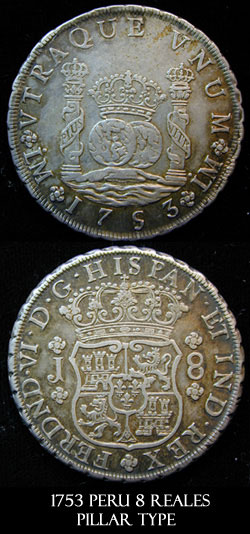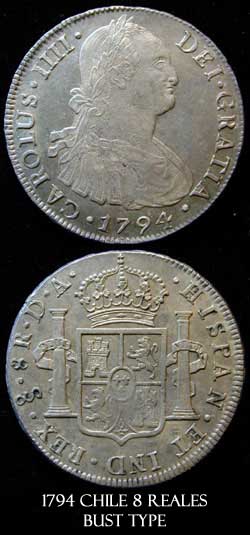The Spanish 8 reales was the world money standard from the time the Mexico Mint started striking coins in the late 1530’s until the 1850’s. The New World 8 reales and the subsidiary 4 reales, 2 reales, 1 reales and 1/2 real started out as crude “cob” coins (See: Spanish Treasure Coins) with irregular shapes, often with parts of the design missing. This made it difficult to ascertain that the coin weighed the proper amount (27.03 grams). 
The Spanish Milled Dollar was a term English speakers gave to the Spanish 8 Reales that was minted on a coin press from 1732-1826. The term “milled” refers to the fact that the coin blanks (planchets) were made on a milling machine and were of consistent weight and size. The introduction of this technologically superior product kept Spanish coins as the basis for the world monetary system.
Starting in 1732 the Mexico Mint began minting coins with the flans held by a collar that impressed a security device on the edge. These coins are round and feature the Pillars of Hercules surrounding crowned, conjoined globes and ocean waves below, hence the other name for this coin, “Pillar Dollar”. To the left of the date is the mint mark. The reverse shows a crowned shield with the assayers initials to the left and the denomination in reales to the right.
Many countries, European and Asian, countermarked Spanish Milled Dollars for use within their own countries. In the United States these coins were legal tender up until the Civil War period. Milled Dollars had a powerful effect on the U.S. coinage system. Our dollar was based on the Spanish Milled Dollar and some of the slang expressions referring to this money still survive today. As an example, the 8 Real was often cut into 8 “bits” to make change. Each bit was worth 12 1/2 cents (100 divided by 8). Though rapidly fading now, the expression 2 bits still refers to a quarter dollar.

Pillar dollars of the first year of issue (1732) are extremely rare and cause a great deal of excitement when they are offered for sale. There are modern copies of this famous coin that were apparently made privately for some commercial purpose. The French inscription gives them away (it translates as “Pillars of Hercules dollar” and refers to the design on the original coin that shows this device. It was a powerful image and symbolized exploration of the great unknown).
For more in-depth information, See: Spanish-American Colonial Coinage
CoinSite Recommended Reference: Pillars & Portraits; A Catalogue of Spanish American silver coins 1732 to 1826
